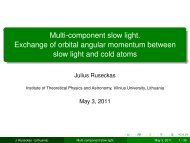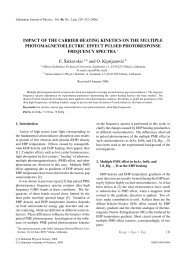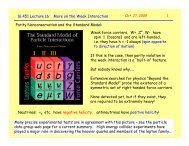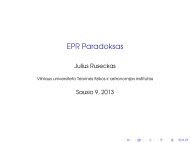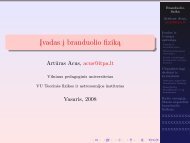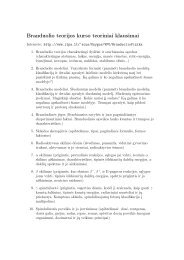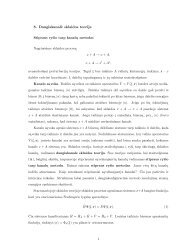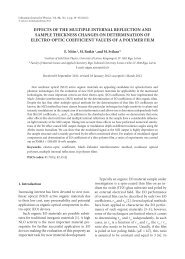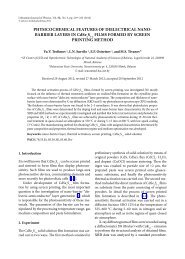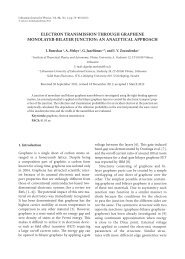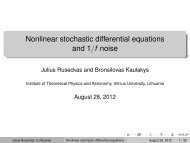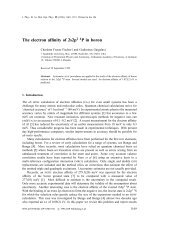DIELECTRIC DISPERSION IN 1,2-DIAMINOPROPANE ...
DIELECTRIC DISPERSION IN 1,2-DIAMINOPROPANE ...
DIELECTRIC DISPERSION IN 1,2-DIAMINOPROPANE ...
You also want an ePaper? Increase the reach of your titles
YUMPU automatically turns print PDFs into web optimized ePapers that Google loves.
Lithuanian Journal of Physics, Vol. 51. No. 4, pp. 313–323 (2011)<br />
© lietuvos mokslų akademija, 2011<br />
<strong>DIELECTRIC</strong> <strong>DISPERSION</strong> <strong>IN</strong> 1,2-DIAM<strong>IN</strong>OPROPANE–<br />
DIMETHYLAM<strong>IN</strong>OETHANOL MIXTURES AS A FUNCTION OF<br />
COMPOSITION AND TEMPERATURE<br />
P. Undre and P. W. Khirade<br />
Microwave Research Laboratory, Department of Physics, Dr. Babasaheb Ambedkar Marathwada University,<br />
Aurangabad-431004, India<br />
E-mail: prabhakarundre@yahoo.co.in<br />
Received 23 April 2011; revised 9 November 2011; accepted 1 December 2011<br />
The dielectric dispersion ε' and dielectric loss ε" of binary mixture of 1,2-diaminopropane–dimethylaminoethanol<br />
were measured by employing the time domain reflectometry technique over a frequency range from<br />
10 MHz to 20 GHz at 288, 298, 308, and 318 K temperatures. The accuracy in the measurement of the ε' and<br />
ε" values obtained from this technique is within ±5%. To evaluate various dielectric parameters, the frequency<br />
dependents complex permittivity (ε*(ω) = ε' – iε") data, viz., static permittivity ε 0<br />
, relaxation time τ, and permittivity<br />
at high frequency ε ∞<br />
were fitted by the nonlinear least-squares fit method to Debye expression. Temperature<br />
dependent ε 0<br />
, τ, Kirkwood correlation factor g, free energy of activation ΔG, and enthalpy of activation<br />
ΔH have been determined and discussed in terms of the effect of –NH 2<br />
and –CH 3<br />
side-group on molecular<br />
dynamics and intermolecular hydrogen bonds. The dielectric behaviour of 1,2-diaminopropane and dimethylaminoethanol<br />
liquid molecules and their conformations as well as molecular dynamics of the system can be<br />
explored only by comparing the dielectric data of the mixture system with the dielectric data of the individual<br />
molecules and their dynamics.<br />
Keywords: dielectric dispersion, dielectric loss, excess parameters, Kirkwood correlation factor,<br />
thermodynamic parameters<br />
PACS: 77.22.Ch, 77.22.Gm, 77.84.Nh<br />
1. Introduction<br />
Microwave energy has been directly applied in<br />
many fields, especially in scientific research such<br />
as communication, microwave-assisted chemistry<br />
and in food industry [1, 2]. A successful application<br />
of microwaves is directly associated with the<br />
dielectric properties of the materials. An accurate<br />
measurement and working knowledge of these<br />
properties are key factors in better understanding<br />
the interaction of microwaves with the materials.<br />
Dielectric relaxation spectroscopy, for instance,<br />
is a powerful tool for examining the underlying<br />
physics of solvent systems and for exploring the<br />
molecular dynamics of liquids, which is characterized<br />
by inter- and intra-molecular structures<br />
that vary rapidly with time.<br />
Studies on the relaxation properties of the mixture<br />
of solvents have provided some interesting<br />
insights into the volumes implicated by the Debye<br />
expression and the nature of the mixing process. If<br />
the solvents are chemically similar and mix well at<br />
the molecular level, then the mixture will often exhibit<br />
a single relaxation time at an average position,<br />
which reflects the molar ratios of two components.<br />
However, if the solvents do not mix well at the molecular<br />
level, then two distinct relaxation times are<br />
observed and they do not differ greatly from those<br />
of pure solvents.<br />
The knowledge of frequency dependent dielectric<br />
properties of solvent systems is important both<br />
in fundamental studies of solvent structure and dynamics<br />
and in practical application of microwave<br />
heating processes [1]. At a fundamental level, the
314<br />
P. Undre and P. W. Khirade / Lith. J. Phys. 51, 313–323 (2011)<br />
frequency dependent dielectric behaviour of solvent<br />
mixtures provides information on molecular<br />
interactions and mechanism of molecular processes.<br />
The dielectric relaxation behaviour of mixtures<br />
of polar molecules under varying conditions<br />
of compositions is very important as it helps in obtaining<br />
information about relaxation processes in<br />
mixtures.<br />
Becker et al. [3] carried out a systematic study<br />
of dielectric relaxation of monohydric alcohol with<br />
dihydric alcohols (diols) solutions at 293 K over<br />
the frequency range of 5 MHz to 72 GHz using<br />
the lumped circuit, coaxial and waveguide method.<br />
The principal component, which is related to the<br />
dynamics of self- and/or hetro-association, is discussed<br />
with respect to steric conditions. In mixtures<br />
of monohydric (1-butanol) with longer chain 1,2-<br />
diols, the principal relaxation time passes through a<br />
minimum on increasing the dihydroxy content. In<br />
mixtures of tert-butanol (which has a weaker selfassociation<br />
tendency) with longer chain 1,n-diols,<br />
on the other hand, it passes through a maximum.<br />
With regard to the principal relaxation strength,<br />
longer chain 1,2-diols tend to resemble monohydric<br />
alcohols of full diol chain length while 1,n-diol<br />
tends to resemble monohydric alcohol of half the<br />
diol chain length.<br />
Sengwa et al. [4] studied the dielectric relaxation<br />
in propylene glycol–poly propylene glycol mixtures<br />
over three concentrations in the frequency range<br />
10 MHz to 4 GHz at 298 K using Time Domain<br />
Reflectometry (TDR). The effective Dielectric relaxation<br />
is shown to depend exponentially on the<br />
number density of dipoles or molecules. Puranik<br />
et al. [5] studied the dielectric properties of ethanol<br />
and ethylene glycol using TDR techniques in<br />
the frequency range of 10 MHz to 10 GHz over the<br />
temperature range 243–313 K. The activation energies<br />
of both systems are compared.<br />
Hanna et al. [6] carried out a dielectric relaxation<br />
study of monohydroxy–dihydroxy alcohols binary<br />
and monohydroxyl–diol-diol ternary mixtures at<br />
293 K over the frequency range from 10 MHz to<br />
10 GHz using the TDR technique. An apparent dipole<br />
moment term and the effective relaxation time<br />
of the main dispersion region are given as a function<br />
of the number density of dipoles.<br />
To compare the influence of different polar<br />
groups in the relaxation mechanism, we have considered<br />
it interesting to perform an analogous treatment<br />
such as that carried out for binary mixture<br />
of primary alcohols-diol, dio-diol. For this reason,<br />
dielectric dispersion study in 1,2-diaminopropane<br />
(DP) with dimethylaminoethanol (DMAE) mixtures<br />
over the frequency range of 10 MHz to 20 GHz<br />
has been carried out using pico-second TDR. The<br />
binary system of DP–DMAE has been selected to<br />
understand the effect of amino and methyl sidegroup<br />
on the dielectric parameters, where the significance<br />
is based upon the tetrahedric nature of the<br />
–NH 2<br />
group. This extreme is of decisive relevance<br />
for the process of chemical synthesis, the behaviour<br />
of amino acids and proteins in biochemical models<br />
related to biogenic amines which contribute to the<br />
mechanism of electrical conduction in the nervous<br />
system, especially in nurotransmission.<br />
This binary system of DP and DMAE is of interest<br />
because of two functional groups in both<br />
components with one common –NH 2<br />
group. The<br />
four sites available for H-bonding in a DP molecule<br />
promote a set of transient cross links between<br />
neighbouring molecules. In such a case, relevant<br />
transient structures such as branched associated<br />
species and/or chains are formed. In addition, many<br />
conformations can be generated for each molecule<br />
by the rotation of CH 2<br />
NH 2<br />
group around the C–C<br />
axis with respect to H 2<br />
N–CH–CH 3<br />
group. DMAE<br />
is a hydroxylamine, tertiary amine, versatile and<br />
polyfunctional molecule that combines the characteristics<br />
of amines and alcohols and is capable of<br />
undergoing reactions typical of both alcohols and<br />
amines. Competition for H-bond site governs the<br />
nature of short-range order around molecules of<br />
both components of the solvent mixture. For the<br />
hydroxyamines, this is the dominant feature. The<br />
molecules of DMAE exist in intermolecular hydrogen<br />
bonded form with the rotation of CH 2<br />
N–<br />
(CH 3<br />
) 2<br />
group around C–O bond in dynamic equilibrium.<br />
The dielectric study of the binary system<br />
of these DP and DMAE molecules will give information<br />
about interaction between OH–NH 2<br />
and<br />
NH 2<br />
–NH 2<br />
group thereby forming different types of<br />
structures.<br />
Due to good solubility of DP in DMAE, these<br />
molecules may form a variety of clusters due to inter-<br />
and intra-molecular hydrogen bonds, depending<br />
on the molecular geometry of individual molecules,<br />
and hence, it is interesting to investigate the<br />
variation in the shapes of the dielectric relaxation<br />
curves of the DP–DMAE system with concentration.
P. Undre and P. W. Khirade / Lith. J. Phys. 51, 313–323 (2011) 315<br />
The concentration dependence of the shape of the<br />
relaxation curves and various dielectric parameters<br />
of the DP–DMAE mixture are compared with those<br />
of the monomeric, dimeric, trimeric and polymeric<br />
molecules in the DP–DMAE solution, to obtain<br />
some insight into the possible relaxation behaviour<br />
of the DP and DMAE molecules in their mixtures.<br />
The relaxation curves are treated assuming one<br />
relaxation process, and their shapes are discussed<br />
based on the cooperativity of DP and DMAE molecules.<br />
The dipole moment value of DP molecules is<br />
slightly larger than the dipole moment values of<br />
DMAE in the gas phase. The values of static permittivity<br />
ε 0<br />
, relaxation time τ, activation enthalpy<br />
ΔH, and Gibbs free energy of activation ΔG for DP<br />
are larger than those for DMAE. The difference in<br />
permittivity values of pure DP and DMAE are due<br />
to difference pattern of alignment of dipoles in liquid.<br />
2. Experimental set-up<br />
2.1. Chemicals<br />
The chemicals used in the present work, 1,2-diaminopropane<br />
and dimethylaminoethanol, were<br />
of spectroscopic grade and were obtained from<br />
ACROS ORGANICS, New Jersey, USA, and Kemphasol,<br />
Bombay, respectively, commercially with<br />
99% purity and were used without further purification.<br />
The solutions were prepared at different<br />
volume percentage of DP in DMAE in the step of<br />
10% at room temperature. The concentrations were<br />
prepared for 5 ml solution at room temperature assuming<br />
ideal mixing behaviour, within 0.02% error<br />
limit.<br />
2.2. TDR set-up and data acquisition<br />
The Hewlett Packard HP54750A sampling oscilloscope<br />
with HP54754A TDR plug-in module has<br />
been used. After observing TDR response for a<br />
sample under study, the time window was kept to<br />
5 ns. By observing TDR response for a sample under<br />
study, the SMA sample cell with 1.35 mm effective<br />
pin length was used. The sample cell holds the liquid<br />
under consideration. The physical dimensions<br />
of the cell are very important, so one must be careful<br />
while designing the sample cell. The impedance<br />
of the cell should be matched with the coaxial transmission<br />
line to which the cell is connected. If there<br />
is impedance mismatch, then unwanted reflections<br />
may disturb the wave thereby causing some errors<br />
in the measurements. The proper design of the cell<br />
includes the inner conductor and outer conductor<br />
diameters. The length of the inner conductor is<br />
called the ‘pin length’ of the cell and is a very important<br />
factor in analysis. The sample length must be<br />
enough to avoid unwanted reflections.<br />
In the total reflection method, the sample length<br />
must be long enough to produce an adequate difference<br />
signal but short enough to keep less complication<br />
of resonance effects at frequencies above<br />
the range of interest.<br />
The characteristic impedance of a coaxial line is<br />
given by<br />
(1)<br />
This impedance for our transmission line is frequently<br />
50 Ω. Here, a is the diameter of inner conductor,<br />
b is the inner diameter of outer conductor,<br />
and ε is the relative permittivity of the dielectric between<br />
the conductors. Using Teflon and air and taking<br />
appropriate a, b, a cell can be designed to have<br />
a matching impedance of Z = 50 Ω (for air ε = 1<br />
and for Teflon ε = 2.2). The sample cell consists of<br />
standard military applications (SMA) coaxial connector<br />
with matched impedance with 3.5 mm inner<br />
diameter of outer conductor. The inner conductor<br />
of SMA connector itself is considered as ‘inner<br />
conductor’ and hex-nut is treated as an outer conductor.<br />
Since these SMA connectors have already<br />
been designed for precise 50 Ω impedance, a special<br />
design, when used with high frequency, is not<br />
required. The physical length of inner conductor<br />
can be changed. When the cell is filled with sample<br />
above the physical length of inner conductor, the<br />
fringing effect takes place [7, 8]. Due to the fringing<br />
field, the effective pin length [9] will not be equal to<br />
the physical pin length. The effective electrical pin<br />
length will be greater than the physical pin length.<br />
The accurate determination of the effective pin<br />
length d is very important for the accurate evaluation<br />
of dielectric parameters. It is found that for<br />
SMA type cell, the effective pin length [9] is greater<br />
than the actual physical length by 0.1–0.2 mm.
316<br />
P. Undre and P. W. Khirade / Lith. J. Phys. 51, 313–323 (2011)<br />
To reduce noise, the time dependent response<br />
curve was averaged for 64 times and then stored in<br />
TDR oscilloscope memory with 1024 points per waveform.<br />
First, the response waveform for an empty cell<br />
is acquired and stored in memory and then, secondly,<br />
the response waveform for a sample is acquired and<br />
stored in other memory. The empty cell waveform is<br />
used as a reference waveform. Both response waveforms<br />
are the reflected waveforms from the sample<br />
cell with the open termination transmission line.<br />
The data acquisition is carried out for 11 concentrations<br />
at 288, 298, 308, and 318 K. The temperature<br />
of a sample was maintained at a desired<br />
value, within accuracy limit of ±1 K, by circulating<br />
constant temperature water through heat insulating<br />
jacket surrounding the sample cell.<br />
At each time the response waveforms without a<br />
sample and with a sample were recorded. The time<br />
dependent response waveform without a sample is<br />
referred to as R 1<br />
(t) and with a sample as R x<br />
(t).<br />
2.3. Data analysis<br />
The time dependent data were processed to obtain<br />
complex reflection coefficient spectra ρ * (ω) over<br />
the frequency range from 10 MHz to 10 GHz using<br />
Fourier transformation as [10, 11]<br />
(2)<br />
where p(ω) and q(ω) are Fourier transformations of<br />
R 1<br />
(t) – R x<br />
(t) and R 1<br />
(t) + R x<br />
(t), respectively, c is the<br />
velocity of light, ω is angular frequency, d is effective<br />
pin length, and i = √-1.<br />
The complex permittivity spectra ε * (ω) [12] were<br />
obtained from reflection coefficient spectra ρ * (ω)<br />
by applying the bilinear calibration method [13].<br />
The complex permittivity spectra measured<br />
using TDR are fitted by the nonlinear least-squares<br />
fit method to the Havriliak–Negami expression<br />
[14] to obtain various dielectric parameters. The accuracy<br />
in the measurement of dielectric dispersion<br />
ε' and dielectric loss ε" values obtained from this<br />
technique is within ±5%.<br />
(3)<br />
where ε * (ω) is the complex permittivity at an angular<br />
frequency ω, ε ∞<br />
is the permittivity at high frequency,<br />
ε is the static permittivity, τ is the relaxation<br />
time of the system, α is the shape parameter<br />
0<br />
representing symmetrical distribution of relaxation<br />
time, and β is the shape parameter of an asymmetric<br />
relaxation curve.<br />
Equation (3) includes Cole–Cole (β = 1) [15],<br />
Davidson–Cole (α = 0) [16], and Debye (α = 0,<br />
β = 1) [17] relaxation models. The dielectric model<br />
for fitting dielectric parameters suitable for present<br />
system is the Debye dispersion model.<br />
3. Results and discussion<br />
Frequency dependence curves for the dielectric<br />
dispersion ε' and absorption ε" of DP–DMAE with<br />
varying volume fraction of DMAE at 298 K are depicted<br />
in Figs. 1 and 2, respectively. In the case of<br />
DP–DMAE mixtures, there is a considerable possibility<br />
of modifications in these homomolecular<br />
clusters due to molecular interactions between the<br />
DP and DMAE molecules. Apart from the complexities<br />
in the DP–DMAE mixtures, the observed<br />
dielectric dispersion behaviour is a simple Debyetype<br />
for all the concentrations studied, and this is<br />
also the case for the individual molecules.<br />
Both ε' (Fig. 1) and ε" (Fig. 2) increase with increasing<br />
volume percentage of DMAE in the binary<br />
mixture DP–DMAE at the low-frequency<br />
end and decrease at the high-frequency end. The<br />
frequency at which the loss factor is a maximum,<br />
Fig. 1. Frequency dependent dielectric dispersion ε'<br />
curves for 1,2-diaminopropane, dimethylaminoethanol<br />
and their mixtures at 298 K.
P. Undre and P. W. Khirade / Lith. J. Phys. 51, 313–323 (2011) 317<br />
f max<br />
(τ = 1/(2πf max<br />
)) shifts to higher values with decreasing<br />
the volume percentage of DMAE in the<br />
mixture, corresponding to their individual relaxation<br />
times, because the individual molecular values<br />
Fig. 2. Frequency dependent dielectric loss (absorption)<br />
ε" curves for 1,2- diaminopropane, dimethylaminoethanol<br />
and their mixtures at 298 K.<br />
are sufficiently different (i. e. 79.21 and 14.23 ps)<br />
to allow their resolution in practice. However, in<br />
a mixture of two associated liquids it seems that<br />
the individual principal relaxation processes of the<br />
components coalesce, and hence the mixture exhibits<br />
a single relaxation time. Earlier, Kumar et al.<br />
[18] observed Debye-type behaviour in amines<br />
(aliphatic/aromatic)–alcohol mixtures, despite<br />
large differences in the values of individual molecule<br />
relaxation times.<br />
The values of the dielectric parameters ε 0<br />
and<br />
τ obtained from Eq. (3) for DP, DMAE and DP–<br />
DMAE with the volume fraction of DMAE at four<br />
different temperatures are recorded in Table 1.<br />
From Table 1 it can be observed that static permittivity<br />
systematically increases with increase in volume<br />
fraction of DMAE in DP. The same type of change in<br />
permittivity values has been observed at four temperatures<br />
under study.<br />
The τ values gradually increase with increase in<br />
volume fraction of DMAE in DP. With increase in<br />
Table 1. Temperature dependent dielectric parameters for binary mixture of dimethylaminoethanol–1,2-diaminopropane.<br />
Number in parenthesis represents error, e. g. 13.06 (02) means 13.06 ± 0.02 X DMAE<br />
volume fraction of<br />
dimethylaminoethanol.<br />
288 K 298 K<br />
X DMAE<br />
ε 0<br />
τ, ps ε 0<br />
τ, ps<br />
0 13.06 (02) 15.12 (09) 12.54 (02) 14.23 (07)<br />
0.1 12.92 (26) 25.08 (89) 12.76 (24) 23.38 (40)<br />
0.2 12.90 (32) 28.63 (28) 12.44 (26) 27.48 (30)<br />
0.3 13.64 (36) 39.25 (50) 13.43 (29) 33.47 (07)<br />
0.4 13.23 (38) 46.74 (30) 13.01 (34) 40.49 (99)<br />
0.5 13.87 (45) 55.28 (30) 13.67 (39) 48.40 (80)<br />
0.6 13.77 (41) 69.47 (75) 13.57 (38) 57.47 (60)<br />
0.7 13.81 (47) 78.70 (70) 13.59 (42) 68.83 (50)<br />
0.8 13.56 (45) 85.20 (48) 13.29 (45) 72.60 (44)<br />
0.9 13.46 (54) 85.81 (45) 13.29 (71) 78.10 (60)<br />
1 13.84 (01) 93.58 (03) 13.68 (05) 79.21 (04)<br />
308 K 318 K<br />
ε 0<br />
τ, ps ε 0<br />
τ, ps<br />
0 11.86 (01) 13.50 (05) 10.75 (01) 11.72 (07)<br />
0.1 12.63 (21) 21.17 (11) 12.59 (15) 15.58 (60)<br />
0.2 12.41 (23) 24.13 (10) 12.20 (28) 18.00 (70)<br />
0.3 12.93 (27) 30.16 (80) 12.63 (20) 23.95 (48)<br />
0.4 12.76 (28) 35.01 (60) 12.16 (22) 27.94 (41)<br />
0.5 13.48 (29) 42.28 (50) 13.19 (24) 32.38 (35)<br />
0.6 13.12 (31) 50.39 (40) 13.03 (22) 37.61 (24)<br />
0.7 13.31(37) 56.16 (35) 13.28 (39) 44.49 (40)<br />
0.8 13.28 (48) 60.99 (42) 13.14 (30) 48.74 (25)<br />
0.9 13.20 (55) 63.13 (40) 12.93 (34) 53.22 (24)<br />
1 13.44 (06) 67.20 (04) 13.17 (05) 58.95 (03)
318<br />
P. Undre and P. W. Khirade / Lith. J. Phys. 51, 313–323 (2011)<br />
temperature, the relaxation time values are decreasing<br />
by maintaining the same type of variation with<br />
change in concentration. In the DP-rich region,<br />
τ values are not so much sensitive with change in<br />
temperature. The values ε 0<br />
as well as τ increase with<br />
increase in volume fraction of DMAE in DP, which<br />
indicates that with increase in the number of dipoles<br />
in the solution, the intermediate structures<br />
formed rotate slowly thereby giving the increase in<br />
the values of τ in the solution.<br />
A large value of τ for DMAE molecules is attributed<br />
to H-bonded polymeric cluster formation.<br />
The primary relaxation of DMAE may be due<br />
to the cooperative process of long chain multimers<br />
with (O–H …. N or may be H–N ... H) linkage. The<br />
observed relaxation time τ of DMAE (79.21 ps) is<br />
much smaller than the τ of ethanolamine (155 ps)<br />
[19] and ethanol (139.85 ps) [20], which suggests<br />
that there is substantial hindrance to molecular<br />
reorientation due to the bulky –CH 3<br />
side group<br />
in ethanol. Moreover, the fact that the τ values<br />
of amines are smaller than homologous alcohols<br />
indicates [21], on the one hand, the weaker<br />
dipolar character of the NH 2<br />
group with respect<br />
to the OH group and, on the other hand, that the<br />
relaxation times for amines are near to the rotation<br />
time of the NH 2<br />
group in its free state. The<br />
τ value of DMAE is much smaller than ethanol<br />
and aminoethanol, which suggests that there is<br />
substantial hindrance to molecular reorientation<br />
due to the terminal hydroxy (OH) and dimethylamine<br />
(–N(CH 3<br />
) 2<br />
) groups. The Kirkwood correlation<br />
factor of propylamine (g = 1.45) [22] is larger<br />
in comparison with DP (g = 1.003), the observed<br />
relaxation time τ of DP (14.23 ps) is much larger<br />
than the τ of propylamine (3.05 ps), which suggests<br />
the fact that there is substantial hindrance to<br />
molecular reorientation due to –NH 2<br />
groups and<br />
also bulky –CH 3<br />
side group of propane. Increase<br />
in volume fraction of DMAE in DP when relaxation<br />
value τ increases is a manifestation of the dielectric<br />
orientation of the clusters containing both<br />
DP and DMAE molecules, which is because of the<br />
continuous breaking and making of H-bonds in<br />
the heterogeneous mixture.<br />
The excess parameters [22, 23] related to ε 0<br />
and τ<br />
provide valuable information regarding interaction<br />
between (solute–solvent) polar–polar liquid mixtures.<br />
These properties are also useful for the detection<br />
of the cooperative domain in the mixture and<br />
may give evidence for the formation of multimers<br />
in the mixture due to intermolecular interaction.<br />
The excess permittivity is defined as<br />
ε E = (ε o<br />
) m<br />
– [(ε o<br />
) A<br />
x A<br />
+ (ε o<br />
) B<br />
x B<br />
)], (4)<br />
where x is the mole fraction, and suffixes m, A, B<br />
represent mixture, liquid A and liquid B, respectively.<br />
The excess inverse relaxation time is defined as<br />
(1/τ) E = (1/τ) m<br />
– [(1/τ) A<br />
x A<br />
+ (1/τ) B<br />
x B<br />
], (5)<br />
which represents average broadening of dielectric<br />
spectra. The inverse relaxation time analogy is<br />
taken from spectral line broadening (which is the<br />
inverse of relaxation time) from the resonant spectroscopy<br />
[24].<br />
In DP–DMAE, three kinds of cooperative domains<br />
are expected due to molecular interactions: cooperative<br />
domain (CD) includes DP molecules only,<br />
CD includes DMAE molecules only, and CD includes<br />
both DP and DMAE molecules. Further, the ratio of<br />
these cooperative domains may vary with concentration<br />
of individual molecules in the mixture. For<br />
the detection of the CD in the mixture, it is useful to<br />
compute the excess permittivity ε E which may provide<br />
evidence for the formation of dimmers/multimers<br />
in the mixture due to molecular interactions.<br />
The obtained excess permittivity and excess<br />
inverse relaxation data for the binary mixture of<br />
DP–DMAE are presented in Figs. 3 and 4, respectively.<br />
The observed ε E is found to be negative at the<br />
DMAE-rich region for all temperatures and at the<br />
DP-rich region at 288 K (Fig. 3). The negative values<br />
of ε E indicate that the total number of dipoles decreases<br />
in the DMAE- and DP-rich region (288 K)<br />
which is due to the opposite alignment of the dipoles<br />
of the interacting DP and DMAE molecules. Further,<br />
the low value of ε E at concentrations near to that of<br />
pure DMAE indicates that there is less interaction<br />
between DP and DMAE molecules, and hence cooperative<br />
domain decreases in comparison with the cooperative<br />
domain including DP–DMAE molecules<br />
at remaining concentrations. The positive value of<br />
ε E indicates that the total number of dipoles in DP–<br />
DMAE increases with the formation of monomeric<br />
or dimeric structures which is due to the parallel<br />
alignments of the dipoles of the interacting DP and<br />
DMAE molecules.
P. Undre and P. W. Khirade / Lith. J. Phys. 51, 313–323 (2011) 319<br />
From Fig. 4 it is found that the (1/τ) E values of<br />
DP–DMAE binary mixtures are negative over the<br />
entire concentration range. The negative peak value<br />
is observed at 80% DP–DMAE concentration. The<br />
negative values of (1/τ) E indicate the formation of<br />
linear structures, probably dimeric, and these rotate<br />
slowly under the influence of an external varying<br />
field.<br />
Different molecules are connected by hydrogen<br />
bonds; it will be necessary to break these bonds<br />
for the dielectric relaxation to be produced. This<br />
question has been envisaged by considering the<br />
Kirkwood correlation factor g [25] which itself expresses<br />
the existing dipolar correlation between the<br />
molecule and its surroundings.<br />
The g for pure liquid can be obtained by the expression<br />
(6)<br />
Fig. 3. Variation of excess permittivity with mole fraction<br />
of dimethylaminoethanol in 1,2-diaminopropane<br />
at various temperatures.<br />
where μ is the dipole moment, ρ is the density of<br />
liquid at temperature T, M is the molecular weight,<br />
k is the Boltzmann constant, and N is the Avogadro’s<br />
number.<br />
The effective averaged angular Kirkwood correlation<br />
factor g eff [26, 27] of the mixed solvents<br />
was determined by the following volume fractionweighted<br />
mixture law:<br />
(7)<br />
Fig. 4. Variation of excess inverse relaxation time with<br />
mole fraction of dimethylaminoethanol in 1,2-diaminopropane<br />
at various temperatures.<br />
where g eff is the effective Kirkwood correlation factor<br />
for a binary mixture, and Φ A<br />
, Φ B<br />
are volume<br />
fraction of liquid A and liquid B, respectively.<br />
Considering the Kirkwood correlation factors g 1<br />
and g 2<br />
for the molecules of liquids 1 and 2 which<br />
contributed proportional to their pure liquid g values<br />
in the binary mixture, Eq. (7) of the Kirkwood<br />
correlation factor can be written as<br />
(8)<br />
where g f<br />
is the corrective Kirkwood correlation factor<br />
for a binary mixture. The evaluated g f<br />
values of<br />
the DP–DMAE mixture are given in Fig. 5.<br />
The calculated values of g eff are presented in Table<br />
2. The g eff values change periodically with change<br />
in concentration of DMAE in binary mixture of<br />
DP–DMAE. This concentration-dependent periodic<br />
behaviour of the investigated mixed solvents
320<br />
P. Undre and P. W. Khirade / Lith. J. Phys. 51, 313–323 (2011)<br />
g f<br />
Fig. 5. Plots of g f<br />
against volume fraction of dimethylaminoethanol<br />
for 1,2-diaminopropane–dimethylaminoethanol<br />
binary mixtures at various temperatures.<br />
confirms the change in dipolar ordering of DMAE<br />
molecules due to their H-bond molecular interactions<br />
with DP molecules. The corrective Kirkwood<br />
correlation factor g f<br />
of the investigated mixtures<br />
deviate from unity (Fig. 5) confirming the change<br />
in net dipolar ordering. The plots of g f<br />
values of<br />
DP–DMAE mixtures have good resemblance with<br />
their corresponding ε E plots, i. e. the mixtures<br />
which have g f<br />
values greater than unity have positive<br />
ε E values, and vice versa (Fig. 3). The g f<br />
values<br />
higher than unity for DP–DMAE mixtures reveal<br />
enhanced in the effective dipolar ordering due to<br />
hetero-molecular H-bond interactions. Whereas<br />
the g f<br />
values of DMAE and DP (288 K) rich region<br />
are less than unity, which suggests that the addition<br />
of a small amount of DMAE breaks a large<br />
amount of H-bonded long-range ordered DP<br />
structures.<br />
Since the Arrhenius plots of log τ vs 1/T displayed<br />
a good linearity for all the studied liquid<br />
mixtures, the kinetic parameters that characterise<br />
the molecular mobility in those systems were evaluated<br />
using the Eyring formula [28, 29].<br />
The dielectric relaxation can be treated as a<br />
rate process involving a path over a potential barrier<br />
[24, 29]. Figure 6(a, b) shows free energy of<br />
activation ΔG of the DP–DMAE mixtures as a<br />
function of temperature at different solution compositions<br />
and as a function of solution composition<br />
at different temperatures, respectively. Over<br />
the temperature range of 288–318 K, ΔG varies<br />
gradually with the mole fraction of DMAE. It is<br />
observed that the ΔG values of DMAE are higher<br />
than those of DP over the temperature range of<br />
288–318 K. This difference is attributed to the formation<br />
of hydrogen bonded networks for DP and<br />
DMAE that tend to increase the effective size of a<br />
rotating dipole and the dielectric frictional force<br />
between the rotating dipole and its neighbouring<br />
molecules. Despite the distinctly different ΔG values<br />
of DP and DMAE and the presence of hydrogen<br />
bonding between DP and DMAE molecules,<br />
there is a gradual increase in ΔG with increase in<br />
DMAE composition as shown in Fig. 6(b), which<br />
Table 2. The value of Kirkwood correlation factor (g eff )<br />
for dimethylaminoethanol–1,2-diaminopropane binary<br />
mixture at various temperatures.<br />
X DMAE<br />
288 K 298 K 308 K 318 K<br />
0 1.02 1.00 0.97 0.88<br />
0.1 0.99 1.01 1.03 1.06<br />
0.2 0.98 0.97 1.00 1.01<br />
0.3 1.04 1.05 1.04 1.04<br />
0.4 0.99 1.00 1.01 0.99<br />
0.5 1.03 1.05 1.07 1.08<br />
0.6 1.01 1.03 1.02 1.05<br />
0.7 1.01 1.02 1.03 1.06<br />
0.8 0.98 0.99 1.02 1.04<br />
0.9 0.96 0.98 1.00 1.01<br />
1 0.98 1.00 1.01 1.02<br />
g eff<br />
Fig. 6(a). Variation of free energy of activation ΔG for<br />
the dipolar relaxation for dimethylaminoethanol–1,<br />
2-diaminopropane binary mixture as a function of<br />
temperature.
P. Undre and P. W. Khirade / Lith. J. Phys. 51, 313–323 (2011) 321<br />
Fig. 6(b). Variation of free energy of activation ΔG for<br />
the dipolar relaxation for dimethylaminoethanol–1,<br />
2-diaminopropane binary mixture as a function of<br />
solution composition.<br />
suggests that the DP and DMAE molecules in the<br />
mixture react to the external field in a strongly<br />
cooperative way rather than individually over the<br />
temperature range of 288–318 K. It also suggests<br />
that there is more hindrance to the rotation of the<br />
DP and DMAE molecule clusters in DP–DMAE<br />
in comparison with the rotation of their homogeneous<br />
clusters. This also supports the conclusions<br />
drawn from the negative values of the excess inverse<br />
relaxation time. Further, the increase in hindrance<br />
to molecular rotation in the mixture is due<br />
to intermolecular interactions between the DP and<br />
DMAE molecules, and hence chain-like structures<br />
are generated in DP–DMAE, which supports the<br />
excess permittivity and relaxation time data. In<br />
the DP–DMAE mixtures, the two different molecules<br />
are suggested to behave interchangeably in<br />
forming the cyclic molecular clusters, yielding a<br />
microscopically homogeneous liquid phase and a<br />
pure Debye-type dielectric dispersion. The primary<br />
relaxation in these mixtures is attributed to the<br />
cooperative process of the cyclic clusters, with the<br />
clusters having an increased dipole moment relative<br />
to the individual molecules. Figure 6(a) shows<br />
that ΔG of DP–DMAE mixtures is a linear function<br />
of temperature over the range of 288–318 K.<br />
The varying relaxation behaviour over the entire<br />
temperature range may be caused by changes in<br />
the hydrogen-bonding ability that produce different<br />
structures of chain-like or cyclic clusters.<br />
Factors such as changes in the angle between the<br />
neighbouring dipoles or in the average number<br />
of molecules in each cluster could yield different<br />
cluster structures. Tsurko et al. [30] reported the<br />
activation energy for the amino acid–propanol binary<br />
mixture. They suggested that the activation<br />
energy increased with increase in mole fraction of<br />
propanol and temperature. Jianfeng Lou et al. [31]<br />
reported ΔG for the nitrobenzene–toluene, ethanol–butanol<br />
and butanol–formamide. They suggested<br />
that ΔG for nitrobenzene–toluene mixture<br />
linearly increases with increase in mole fraction<br />
of nitrobenzene and temperature, consistent with<br />
the ideal dielectric mixing behaviour that might<br />
be expected on the basis of the nature of these solvent<br />
mixtures. Nitrobenzene and toluene are polar<br />
and non-polar solvents, respectively, and they do<br />
not associate with each other or with like molecules.<br />
But in case of ethanol–butanol and butanol–<br />
formamide, ΔG linearly increases with increase in<br />
compositions but decreases with increase in temperature.<br />
This may be due to the molecules in both<br />
mixtures reacting to the external field in a strongly<br />
cooperative way.<br />
An interesting trend may be observed in the<br />
temperature-dependent relaxation time for the<br />
DP–DMAE binary mixture. The most probable relaxation<br />
time determined for the DP–DMAE binary<br />
mixture decreases with increasing temperature. In<br />
general, this type of temperature-dependent effect<br />
could indicate either a temperature-dependent rate<br />
process with activation energy or an equilibrium<br />
process with an enthalpy change between the two<br />
(or perhaps more) states (ΔH).<br />
The value of ΔH increases with increase in<br />
volume fraction of DMAE in DP from 3.72 kJ/<br />
(K.mol) to 12.23 kJ/(K.mol) with increase in volume<br />
fraction of DMAE up to 0.6 in the mixture<br />
of DP–DMAE (Table 3). This indicates that more<br />
energy is needed for group dipole reorientation<br />
with increase in volume fraction of DMAE in the<br />
mixture. There is an increase in agitation with increase<br />
in volume fraction of DMAE up to 60%<br />
in the mixture, which may be due to the interaction<br />
in NH 2<br />
–NH 2<br />
group or may be due to NH 2<br />
–<br />
OH group. Furthermore, ΔH decreases towards<br />
the corresponding ΔH value of pure DMAE.<br />
A large value of ΔH at 0.6 volume fraction of<br />
DMAE indicates strong hydrogen bonding in the<br />
solution.
322<br />
P. Undre and P. W. Khirade / Lith. J. Phys. 51, 313–323 (2011)<br />
Table 3. The activation enthalpy (ΔH) of dimethylaminoethanol–1,2-diaminopropane<br />
binary mixture for<br />
various concentrations.<br />
X DMAE<br />
Activation enthalpy ΔH,<br />
kJ/(K.mol)<br />
0 3.72<br />
0.1 8.81<br />
0.2 8.86<br />
0.3 9.22<br />
0.4 10.23<br />
0.5 10.75<br />
0.6 12.23<br />
0.7 11.53<br />
0.8 11.17<br />
0.9 10.08<br />
1 9.02<br />
4. Conclusions<br />
The dielectric dispersion ε' and dielectric loss<br />
ε" of binary mixture of 1,2-diaminopropane in<br />
dimethylaminoethanol have been studied using<br />
the TDR technique in the frequency range from<br />
10 MHz to 20 GHz over entire concentration at<br />
288, 298, 308, and 318 K. Both ε' and ε" increase<br />
with increase in volume percentage of DMAE in<br />
DP–DMAE mixture at the low-frequency end and<br />
decrease at the high-frequency end. The ε 0<br />
as well<br />
as τ values increase with increase in volume fraction<br />
of DMAE in DP, which indicates that with<br />
increase in the number of dipoles in the solution<br />
the intermediate structures formed rotate slowly<br />
thereby giving the increase in the values of τ in<br />
the solution. The plots of g f<br />
values of DP–DMAE<br />
mixtures have good resemblance with their corresponding<br />
ε E plots, i. e. the mixtures which have<br />
g f<br />
values greater than unity, have positive ε E values,<br />
and vice versa. The g f<br />
values higher than unity for<br />
DP–DMAE mixtures reveal enhancement in the<br />
effective dipolar ordering due to hetero-molecular<br />
H-bond interactions. The dielectric behavior<br />
of 1,2-diaminopropane and dimethylaminoethanol<br />
liquid molecules and their conformations as<br />
well as molecular dynamics of the system can be<br />
explored only by comparing the dielectric data of<br />
the mixture system with the dielectric data of the<br />
individual molecules and their dynamics.<br />
References<br />
[1] C. Gabriel, S. Gabriel, E.H. Grant, B.S.J. Halstead,<br />
and D.M.P. Mingos, Chem. Soc. Rev. 27, 213 (1998).<br />
[2] W. Kuang, and S.O. Nelson, J. Microw. Power<br />
Electromagn. Energ. 32, 114 (1997).<br />
[3] U. Becker and M. Stockhausen, J. Mol. Liq. 81, 89<br />
(1999).<br />
[4] R.J. Sengawa, R. Chaudhary, and S.C. Mehrotra,<br />
Polymer 43, 1467 (2002).<br />
[5] S.M. Puranik, A.C. Kumbharkhane, and<br />
S.C. Mehrotra, Indian J. Phys. 67(B), 9 (1993).<br />
[6] F.F. Hanna, Bo Gestblom, and A. Soliman, J. Mol.<br />
Liq. 95, 27 (2000).<br />
[7] M.J.C. van Gemert, Adv. Mol. Relaxation Processes<br />
6, 123 (1974).<br />
[8] D. Bertolini, M. Cassettari, S. Salvetti, E. Tombari,<br />
and S. Veronesi, Rev. Sci. Instrum. 61, 2416 (1990).<br />
[9] J.G. Berberian and E. King, J. Non-Cryst. Solids.<br />
305, 10 (2002).<br />
[10] C.E. Shannon, Proc. Inst. Radio Eng. 37, 10<br />
(1949).<br />
[11] H.A. Samulan, Proc. Inst. Radio Eng. 39, 175<br />
(1951).<br />
[12] S. Mashimo, S. Kuwabara, S. Yogihara, and K. Higasi,<br />
J. Chem. Phys. 90, 3292 (1989).<br />
[13] R.H. Cole, J.G. Berbarian, S.G. Chryssikos, A. Burns,<br />
and E. Tombari, J. Appl. Phys. 66, 793 (1989).<br />
[14] S. Havriliak and S. Negami, J. Polymer. Sci. C 14, 99<br />
(1966).<br />
[15] K.S. Cole and R.H. Cole, J. Chem. Phys. 9, 341<br />
(1941).<br />
[16] D.W. Davidson and R.H. Cole, J. Chem. Phys. 18,<br />
1484 (1950).<br />
[17] P. Debye, Polar Molecules The Chemical Catalogue<br />
Co., New York, 1929).<br />
[18] S. Kumar, T. Ganesh, S. Krishana, and S.C. Mehrotra,<br />
Bull. Pure Appl. Sci. D 20(1), 125 (2001).<br />
[19] P. Undre, S.N. Helambe, S.B. Jagdale, P.W. Khirade,<br />
and S.C. Mehrotra, J. Mol. Liq. 137, 147 (2008).<br />
[20] B.G. Lone, P.B. Undre, S.S. Patil, P.W. Khirade, and<br />
S.C. Mehrotra, J. Mol. Liq. 141, 47 (2008).<br />
[21] A. Volmari and H. Weingartner, J. Mol. Liq. 98–99,<br />
293 (2002).<br />
[22] F.J. Arcega, J.M. Fornies-Marquina, A.M. Bottreau,<br />
and G. Vicq, An. Fys. 77 B, 28 (1981).<br />
[23] M. Tabellout, P. Lanceleur, J.R. Emery, D.Hayward,<br />
and R.A. Pethrick, J. Chem. Soc. Farad. and Trans.<br />
86, 1493 (1990).<br />
[24] J. Lou, T.A. Hatton, and P.E. Laibinis, J. Phys. Chem.<br />
A 101, 5262 (1997).<br />
[25] G. Oster and J.G. Kirkwood, J. Chem. Phys. 11, 175<br />
(1943).<br />
[26] A.C. Kumbharkhane, S.M. Puranik, and<br />
S.C. Mehrotra, J. Solution Chem. 22, 219 (1993).<br />
[27] G. MouMouzlas, D.K. Panpoulos, and G. Ritzoulis,<br />
J. Chem. Eng. Data 36, 20 (1991).
P. Undre and P. W. Khirade / Lith. J. Phys. 51, 313–323 (2011) 323<br />
[28] N.E. Hill, W. Vaughan, A.H. Price, and M. Davies,<br />
Dielectric Properties and Molecular Behaviour (Van<br />
Nostrand Reinhold Co., London, 1969).<br />
[29] S. Glasstone, K.J. Laidler, and H. Eyring, The Theory<br />
of Rate Processes (McGraw-Hill Book Co., New York,<br />
1941).<br />
[30] E.N. Tsurko, T.M. Shihova, and N.V. Bondarev,<br />
J. Mol. Liqs. 96–97, 425 (2002).<br />
[31] J. Lou, A.K. Paravastu, P.E. Laibinis, and T.A. Hatton,<br />
J. Phys. Chem. A 101, 9892 (1997).<br />
DIELEKTR<strong>IN</strong>Ė DISPERSIJA 1,2-DIAM<strong>IN</strong>OPROPANO IR<br />
DIMETILAM<strong>IN</strong>OETANOLIO MIŠ<strong>IN</strong>IUOSE, PRIKLAUSANTI NUO SUDĖTIES IR<br />
TEMPERATŪROS<br />
P. Undre, P. W. Khirade<br />
Babasaheb Ambedkar Marathwada universiteto Fizikos katedra, Aurangabadas, Indija<br />
Santrauka<br />
Dielektrinė dispersija ε' ir dielektriniai nuostoliai<br />
ε" dvinariuose 1,2-diaminopropano ir dimetilaminoetanolio<br />
mišiniuose matuoti laikinės reflektometrijos<br />
metodu 10 MHz – 20 GHz dažnių ruože, esant 288,<br />
298, 308 ir 318 K temperatūrai. Šiuo metodu matuojant<br />
ε' ir ε" vertes matavimo paklaida yra ne didesnė<br />
nei ±5 %. Siekiant įvertinti įvairius dielektrinius<br />
parametrus, nuo laiko priklausančios kompleksinės<br />
skvarbos (ε* (ω) = ε'– i ε") duomenys, pavyzdžiui,<br />
statinė dielektrinė skvarba (ε 0<br />
), relaksacijos trukmė<br />
(τ) ir skvarba esant aukštam dažniui (ε ∞<br />
), netiesiniu<br />
mažiausių kvadratų metodu aproksimuoti Debajaus<br />
formule. Iš nustatytų ε 0<br />
, τ, Kirkvudo (Kirkwood) koreliacijos<br />
daugiklio (g), aktyvacijos laisvosios energijos<br />
(ΔG) ir aktyvacijos entalpijos (ΔH) temperatūrių<br />
priklausomybių daromos išvados apie -NH 2<br />
ir -CH 3<br />
šoninių grupių įtaką molekulinei dinamikai ir tarpmolekuliniams<br />
vandeniliniams ryšiams. 1,2-diami nopropano<br />
ir dimetilaminoetanolio skysčių molekulių<br />
ir jų konformacijų dielektrinės savybės bei molekulių<br />
dinamika gali būti ištirtos tik palyginus dielektrinius<br />
mišinio sistemos duomenis su pavienių molekulių ir jų<br />
dinamikos dielektriniais duomenimis.



